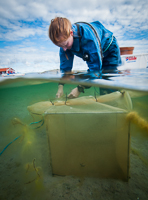ABSTRACT
There is an increasing interest to restore the ecosystem services that eelgrass provides, after their continuous worldwide decline. Most attempts to restore eelgrass using seeds are challenged by very high seed losses and the reasons for these losses are not all clear. We assess the impact of predation on seed loss and eelgrass establishment, and explore methods to decrease seed loss during restoration in the Swedish northwest coast.
In a laboratory study we identified three previously undescribed seed predators, the shore crab Carcinus maenas, the hermit crab Pagurus bernhardus and the sea urchin Strongylocentrotus droebachiensis, of which shore crabs consumed 2-7 times more seeds than the other two species. The importance of shore crabs as seed predators was supported in field cage experiments where one enclosed crab caused 73% loss of seeds over a 1-week period on average (~ 21 seeds per day).
Seedling establishment was significantly higher (14%) in cages that excluded predators over an 8-month period than in uncaged plots and cages that allowed predators but prevented seed-transport (0.5%), suggesting that seed predation constitutes a major source of seed loss in the study area. Burying the seeds 2 cm below the sediment surface prevented seed predation in the laboratory and decreased predation in the field, constituting a way to decrease seed loss during restoration.
Shore crabs may act as a key feedback mechanism that prevent the return of eelgrass both by direct consumption of eelgrass seeds and as a predator of algal mesograzers, allowing algal mats to overgrow eelgrass beds. This shore crab feedback mechanism could become self-generating by promoting the growth of its own nursery habitat (algal mats) and by decreasing the nursery habitat (seagrass meadow) of its dominant predator (cod). This double feedback-loop is supported by a strong increase of shore crab abundance in the last decades and may partly explain the regime shift in vegetation observed along the Swedish west coast.
DOI: 10.1371/journal.pone.0168128











